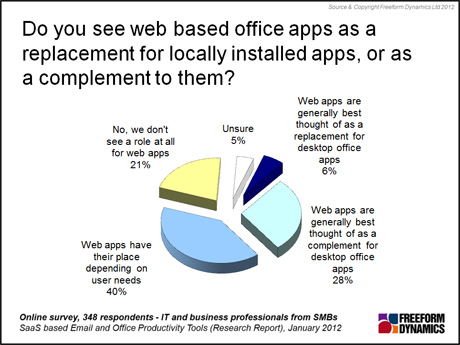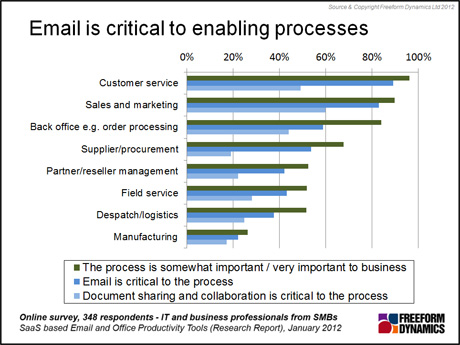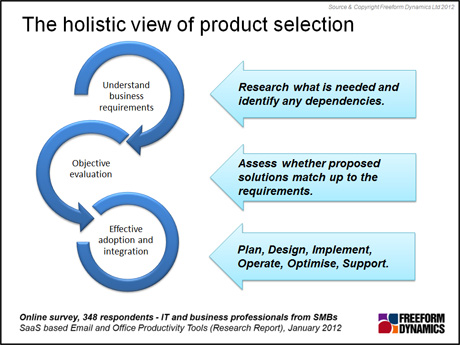Considerations for SaaS-based email and office productivity tools
Why go to all the trouble of installing and maintaining your own email system and office productivity tools when you could instead get them ‘from the cloud’, on a software-as-a-service (SaaS) basis? This is the question that’s been posed for some time now, in particular by vendors keen to challenge Microsoft’s dominance on the desktop. And it can be argued that the assault has been successful to a degree, given that Microsoft now offers its own web-based solution set. But does this mean cloud-based office applications are now widely accepted and adopted as an alternative to on-site deployments?
The answer to that question isn’t entirely clear-cut. Research carried out by Freeform Dynamics suggests that very few are ready to embrace a cloud-only approach. Equally, we’re not looking at an environment of wholesale rejection. When we asked IT and business professionals in an online survey about their attitudes to SaaS in general, and SaaS-based office productivity tools in particular, the majority of respondents felt that web-based desktop office applications may have a place as a complement to tools deployed in-house, or dependent on user requirements (Figure 1).

Figure 1
It should be noted that our survey was focused on companies with fewer than 1000 employees, and it’s likely that a survey of this sort is more likely to attract respondents with an interest in SaaS. This implies that the market as a whole may well be less ready for web-only office solutions than indicated by the numbers shown in Figure 1. It’s also worth mentioning that of course ‘SaaS’ and ‘web-based’ aren’t synonymous. Hosted email services can be accessed via locally installed clients, and in-house email can be accessed via browser-based interfaces. While some speculate that pure web-based tools will be the future, we’re likely to continue to see a variety of approaches in the near to medium term.
Aside from ingrained preferences for doing as much in-house as possible, the key reasons for being sceptical about web-based applications include worries about security, loss of connectivity, service quality, back-up and disaster recovery, as well as data governance issues.
In addition to those concerns, migration and integration with existing systems can be an overriding worry, given how widely office productivity solutions are used, and how deeply embedded they are in many of an organisation’s most critical business processes. If a process can’t function, or can’t function effectively, when a critical element is missing, then the risk of disruption to the business is commensurately more likely. As can be seen in Figure 2, email in particular has become very closely associated with the effective working of many of an organisation’s key processes.

Figure 2
So what could motivate people to look towards the cloud for their office productivity software? As might be expected, cost savings come top of the list for many. But other factors are important as well. These include the ability to do new things more easily, enjoy greater overall reliability, and generally benefit from a more modern environment. Many organisations would also place high priority on having support for all relevant mobile devices. One aspect that plays less of a role, according to our survey respondents, is fitness for purpose. Comparatively few feel that their current office productivity suite simply isn’t up to the job.
Whatever the considerations and views may be in favour of, or against, adopting a SaaS-based office productivity solution, it remains paramount that organisations go through a very thorough process of assessment and selection (Figure 3).

Figure 3
In particular, it’s essential for business and IT management to take into account the impact on core processes in order to minimise the risk of disruption, and to analyse in detail which challenges and risks need to be mitigated, and how. It also means being very clear about the potential business benefits expected from any move to the cloud.
If you’re interested in a more in-depth view of SaaS-based email and office productivity tools, you can download the complete report free of charge.
CLICK HERE TO VIEW ORIGINAL PUBLISHED ON

Content Contributors: Martha Bennett
Through our research and insights, we help bridge the gap between technology buyers and sellers.



Have You Read This?
Generative AI Checkpoint
From Barcode Scanning to Smart Data Capture
Beyond the Barcode: Smart Data Capture
The Evolving Role of Converged Infrastructure in Modern IT
Evaluating the Potential of Hyper-Converged Storage
Kubernetes as an enterprise multi-cloud enabler
A CX perspective on the Contact Centre
Automation of SAP Master Data Management